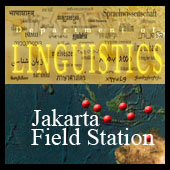| (The Former) Jakarta Field Station of the Max Planck Institute for Evolutionary Anthropology | |
 | |
| Data | |
| Projects | |
| Language Acquisition | |
| Bilingual Language Acquisition | |
| Language Contact | |
| Language Description | |
| Language Experiments | |
| Javanese Dialectology | |
| Metaphor and Emotion | |
| Collaborative Projects | |
| Documentation of Kenyah | |
| Figurative Language | |
| Language and Thought | |
| Phon. of Jakarta Indonesian | |
| Traditional Jambi Malay | |
| Moluccan [external link] | |
| Acquisition of Passive Voice | |
| Sociolinguistic Questionnaire | |
| Former Collaborative Projects | |
| Acq. of Morpho-phonology | |
| Publications & Conf. Papers | |
| News | |
| Regular Events | |
| Events | |
| The Jakarta Forum | |
| Contact Us | |
| People | |
| Site Map | |
| Links | |
| Impressum | |
Documentation of the Banyumasan
Research assistant: Singgih Sugiarto
This project describes phonetic and phonological features unique to the dialect of Banyumas, including phonemic inventories and phonological realizations. For example, the vowel /a/ in final position is pronounced as [a] like in the word apa 'what' which is pronounced as [apa]. In most other dialects, there is vowel raising and vowel harmony which affects final [a], but they are not present in Banyumas. In another salient example, particularly given the widespread prevalence of final devoicing in western Indonesian languages, the consonant /g/ in final position does not undergo devoicing, and so is pronounced [g], like in the word endhog 'egg' which is pronounced as [ɛnɖɔg]. From the examples above, we can find differences between Banyumasan and the 'standard' Javanese dialect (Solo/Yogya). In the Solo/Yogya dialect, the vowel /a/ in open syllables in final position undergoes vowel raising and then there is a harmony rule which spreads this to an immediately preceding /a/ in an open syllable (there are further restrictions on the process) producing apa 'what' pronounced as [ɔpɔ]. Even more widespread across the various dialects of Javanese is devoicing of final consonants. This is a very unique aspect to Banyumasan, and is clearly a late development in that it is not shared with almost any other dialect (as opposed to the lack of vowel raising and harmony, which is also absent from a number of other 'peripheral' dialects). In the 'standard' dialects, endhog 'egg' is pronounced [ɛnɖɔʔ], with both devoicing and glottilization. In Banyumasan, however, the voicing is retained [ɛnɖɔg].
Last modified: 12 Apr 2007, London, UK
Location: banyumas.php.html